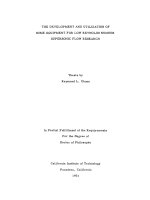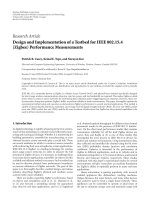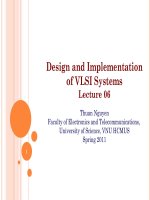Design and preparation of oxygen electrocatalysts for nonaqueous lithium oxygen batteries
Bạn đang xem bản rút gọn của tài liệu. Xem và tải ngay bản đầy đủ của tài liệu tại đây (11.2 MB, 179 trang )
DESIGN AND PREPARATION OF OXYGEN
ELECTROCATALYSTS FOR NONAQUEOUS
LITHIUM-OXYGEN BATTERIES
Lu Meihua
(M. Sci., National University of Singapore)
A THESIS SUBMITTED
FOR THE DEGREE OF DOCTOR OF PHILOSOPHY
DEPARTMENT OF CHEMICAL and BIOMOLECULAR ENGINEERING
NATIONAL UNIVERSITY OF SINGAPORE
2014
Declartion
i
DECLARATION
I hereby declare that the thesis is my original work and it has been
written
by
me in its entirety. I have duly acknowledged all the
sources of
information
which have been used in the
thesis.
This thesis has also not been submitted for any degree in any
university previously.
Lu Meihua
13 August
2014
Acknowledgement
ii
ACKNOWLEDGEMENT
First and foremost, my heartfelt thanks and sincere gratitude to my supervisor,
Professor Lee Jim Yang for his constant guidance, help, timely advice and continuous
encouragement all these years. I appreciate the candor and the many sessions of in-
depth discussions which have sharpened my thought process. His dedication and
enthusiasm for scientific research, his knowledge which is both broad-based and
focused, and his stories on the successful integration of ideas across different
disciplines, have always been a source of inspiration.
I would like to express my sincere thanks to all my friends and colleagues in the
research group, in particular, Dr. Xu Chaohe, Dr. Yu Yue, Dr. Ji Ge, Dr. Chen
Dongyun, Dr. Qu Jianglan, Dr. Liu Bo, Dr. Zhang Chao, Dr. Fang Chunliu, Dr. Ma
Yue, Dr. Zhang Qingbo, Dr. Yang Shiliu, Dr. Li Jinfa, Mr. Ding Bo, Mr. Yao
Qiaofeng, Mr. Zhan Yi, Mr. Qu Baihua, Mr. Yang Liuqing, Mr. Jiang Xi, Mr. Chia
Zhiwen, Mr. Cheng Chin Hsien, Mr. Bao Ji, and. I thank them for their valuable
suggestions and stimulating discussions.
I am indebted to the technical staff in the department especially Mr. Boey Kok Hong,
Mr. Chia Phai Ann, Dr. Yuan Zeliang, Mr. Mao Ning, Ms. Lee Chai Keng, Mr. Liu
Zhicheng, and Ms. Lim Kwee Mei. Their superb technical service and support are
essential for the timely completion of this study.
Last but not least, I’d like to thank the continuous support from my family members.
Without their support and encouragement, this work can not be done.
Acknowledgement
iii
The financial supports by the way of Research Scholarship from the National
University of Singapore (NUS) are greatly acknowledged.
Tableofcontent
iv
TABLE OF CONTENT
DECLARATION I
ACKNOWLEDGEMENT II
TABLE OF CONTENT IV
SUMMARY VIII
LIST OF TABLES XI
LIST OF FIGURES XII
LIST OF SCHEMES XVII
LIST OF ABBREVIATIONS XVIII
CHAPTER 1 INTRODUCTION 1
1. 1 Background 1
1. 2 Objectives and scope 4
CHAPTER 2 LITERATURE REVIEW 9
2. 1 The dawn of lithium oxygen batteries 9
2. 2 The components of lithium oxygen batteries and their issues 11
2.2.1 Major cell configurations of LOBs 11
2.2.2 Lithium anode 15
2.2.3 Electrolyte 16
2.2.3.1 Aprotic Solvent 16
2.2.3.2 Other solvents 22
2.2.4 Lithium salts 23
2.2.5 Oxygen cathode 24
2. 3 Cathode catalysts 25
2.3.1 Carbon based materials 26
2.3.2 Noble metals 34
Tableofcontent
v
2.3.3
Transition metal oxides 37
2.3.4 Redox mediators 47
CHAPTER 3 NITROGEN-DOPED HOLLOW MESOPOROUS CARBON
SPHERES FOR THE IMPROVEMENT OF THE CATALYTIC
PERFORMANCE OF AuPt NANOPARTICLES IN NON-AQUEOUS
LITHIUM OXYGEN BATTERIES 52
3. 1 Introduction 52
3. 2 Experimental Section 55
3.2.2 Synthesis the AuPt (1:1)/HMCMS composite: 56
3.2.3 Materials Characterization: 56
3. 3 Results and Discussion 58
3.3.1 Morphology and Structures 58
3.3.2 Full Cell Tests 64
3. 4 Conclusions 71
CHAPTER 4 EFFECTIVENESS OF Au/Ag NANOCLUSTER-MNO
2
NANOWIRE
HYBRIDS FOR OXYGEN ELECTROCATALYSIS IN NON-
AQUEOUS SOLUTION 73
4. 1 Introduction 73
4. 2 Experimental Section 76
4.2.1 Synthesis of -MnO
2
NWs: 76
4.2.2 Synthesis of Au cluster-α-MnO
2
NW (Au-MnO
2
) and Ag cluster-α-MnO
2
NW (Ag-MnO
2
) hybrids: 76
4.2.3 Materials Characterization: 77
4. 3 Results and Discussion 77
4.3.1 Morphology and Structures 77
Tableofcontent
vi
4.3.2
Full Cell Tests 84
4. 4 Conclusions 93
CHAPTER 5 COBALT OXIDE NANOFLOWER-CARBON NANOTUBE
COMPOSITE 94
5. 1 Introduction 94
5. 2 Experimental Section 97
5.2.1 Synthesis of CoO-CNT hybrid: 97
5.2.4 Electrochemical Measurements: 98
5. 3 Results and Discussion 98
5.3.1 Morphology and Structures 98
5.3.2 Full Cell Tests 105
5. 4 Conclusions 113
CHAPTER 6 LANTHANUM COABLT OXIDE - REDUCED GRAPHENE OXIDE
COMPOSITES 114
6. 1 Introduction 114
6. 2 Experimental Section 117
6.2.5 Materials Characterization: 119
6. 3 Results and Discussion 120
6.3.1 Morphology and Structures 120
6.3.2 Full Cell Tests 129
6. 4 Conclusions 140
CHAPTER 7 CONCLUSION AND FUTURE WORK 142
7. 1 Conclusions 142
7. 2 Future Work 146
Tableofcontent
vii
7.2.1
Optimization of mass and charge transport properties of CoO-based
catalysts 146
7.2.2 Substitutes for the commonly-used carbon paper electrode substrate 147
Summary
viii
SUMMARY
Nonaqueous lithium-oxygen batteries (LOBs) have drawn substantial publicity for
nearly two decades primarily because of the lure of an extremely high specific energy
which can be used to build large scale electrical energy storage systems (EES). Their
theoretical specific energy of 11,680 Wh.kg
-1
(based on the weight of lithium only) is
comparable to that of gasoline (13,000 Wh.kg
-1
) and significantly higher than those of
the state-of-the-art lithium ion batteries (LIBs). However, the commercialization of
LOBs is fraught with many technical challenges such as the instability of the lithium
anode, electrolyte decomposition, and the sluggish kinetics of the oxygen cathode.
Among them, the slow kinetics of the oxygen reduction reaction (ORR) during
discharge and of the oxygen evolution reaction (OER) during recharge is the most
critical one. The development of effective oxygen electrocatalysts is the only solution
to improve the reaction kinetics at the oxygen electrode.
This thesis research presents our designs of oxygen electrocatalysts that could improve
the capacity, rate capability, and cycle stability for nonaqueous LOBs. Noble metal
alloys, noble metal clusters, simple and complex transition metal oxides (perovskite),
and selective carbon nanomaterials (multiwall carbon nanotubes, nitrogenated hollow
mesoporous carbon spheres and nitrogenated reduced graphene oxide sheets) were
used in various combinations to form hybrid catalytic systems for evaluation in full
LOB systems.
The results of this thesis research are discussed over 7 chapters. Chapter 1 contains
primarily statements of purpose and defines the scope of work. Chapter 2 provides an
overview of recent literature relevant to this research. Chapter 3 presents the first
Summary
ix
composite catalyst for oxygen electrocatalysis in this thesis study - AuPt alloy
nanoparticles supported on hollow mesoporous carbon microspheres (AuPt/HMCMS).
Electrochemical measurements indicated that this catalyst was able to deliver a high
specific capacity of 6000 mAh/g at a relatively high current density of 100 mA/g. A
full cell with this catalyst could be cycled steadily to a capacity of 1000 mAh/g at 100
mA/g for 70 cycles. Chapter 4 explores the hitherto unreported use of metal clusters in
conjunction with MnO
2
as potential oxygen electrocatalysts. The hybrids were in the
form of Au clusters on -MnO
2
nanowires (Au-MnO
2
) and Ag clusters on -MnO
2
nanowire (Ag-MnO
2
). The former was the better of the two, which also out-performed
MnO
2
nanowires without any metal clusters. In fact the Au-MnO
2
catalyst was as good
as the AuPt/HMCMS catalyst (Chapter 3) in term of capacity and cycling stability in
full cell tests. The development of non-noble metal catalyst systems are discussed in
Chapter 5 and Chapter 6. Chapter 5 describes the preparation of carbon-coated flower-
like aggregates of cobalt oxide NPs on multiwall carbon nanotubes (CoO-CNT) as a
hybrid catalyst. Each CoO NP was coated with thin layer of nitrogenated carbon and
the CoO nanoflowers were anchored onto the CNTs to increase the extrinsic
conductivity of individual CoO NP and the hybrid. The CoO-CNTs catalyst delivered
excellent full cell performance. Morphology examination of the catalyst during
discharge and charge explained the effectiveness of the CoO-CNTs system for OER;
indicated the effectiveness of the charge transfer property modification. Chapter 6
reports the performance of hybrids of LaCoO
3
nanoparticles (LCO) with reduced
graphene oxide (rGO) nanosheets. The rGO content was investigated at two levels -
7.5wt% and 11.5wt% resulting in two composites designated as LCO-rGO-7.5 and
LCO-rGO-11.5 respectively. The LCO-rGO-11.5 catalyst surpassed LCO-rGO-7.5,
rGO and LaCoO
3
in terms of specific capacity in full cells tests although the LCO-
Summary
x
rGO-7.5 had the best cycling performance. The thesis ends with some overall
concluding remarks and suggestions for future work in Chapter 7.
Listoftables
xi
LIST OF TABLES
Table 2.1. Comparison of the electrochemical performance of the MnO
2
-based
electrodes in LOBs 39
Table 2.2. Comparison of the electrochemical performance of cobalt oxide-based
electrodes in LOBs. 42
Table 2.3. Comparison of the electrochemical performance of perovskite-based
electrodes in LOBs. 44
Table 2.4. Comparison of the electrochemical performance of spinel-based
electrodes in LOBs. 45
Table 3.1 EDX elemental mapping results of C, N, Au and Pt in AuPt/HMCMS
composite. 62
Table 6.1 Specific capacity and discharge/charge oeverpotentials of cells with
rGO, LCO NP, LCO-rGO-10.5 and LCO-rGO-7.5 composites catalysts.
130
Table 6.2 Specific capacity and discharge/charge voltages of cells with LCO-
rGO-10.5 and LCO-rGO-7.5 composite catalysts at different current
densities. 132
Table 7.1 Capacity, rate capability and cycling performance comparisons of the
four catalysts in this study. 145
Listoffigures
xii
LIST OF FIGURES
Figure 2.1
Theoretical and practical specific energies of rechargeable batteries.
[31]
9
Figure 2.2 The four major cell configurations for LOBs.
[31]
11
Figure 2.3 Proposed reactions between carbonate solvents and oxygen species to
explain the various compounds detected in discharge: Li propyl
dicarbonate, Li formate, Li acetate, Li
2
CO
3
, CO
2
, and H
2
O.
[43]
18
Figure 2.6 (a) First cycle of discharge and charge of the Li–O
2
battery with a
MWCNTP cathode at 500 mAh/g between 2.3 and 4.6 V and (b) 50
cycles of discharge and charge at 250 mA/g to a DOD of 1000 mAh/g.
[18]
27
Figure 2.7 (a) SEM image of the AAO filter after nanofiber growth. Inset:
schematic representation of the electrode after the catalyzed growth of
carbon nanofibers. (b) Rate capability of CNF electrodes in the first
discharge cycle with the lower voltage cut-off set at 2.0 V vs. Li. (c)-(e)
Evolution of Li
2
O
x
discharge product morphology. Insets show the
corresponding discharge voltage profiles. (c) Discharge to a capacity of
350 mAh/g at 68 mA/g. (d) Discharge to a capacity of 1880 mA h/g at
64 mA/g. (e) Discharge to a capacity of 7200 mA h/g at 63 mA/g.
[73]
27
Figure 2.8 SEM images of the CNT fibril at a) low magnification (inset: large area
image of the air electrode), and b) at high magnification.
[75]
28
Figure 2.11 (a) Schematic illustration of O
2
/Li
2
O
2
conversion in an ordered
hierarchical mesoporous/macroporous carbon catalyst; (b) SEM of
MMCSAs; (c)-(d) TEM of MMCSAs.
[82]
31
Figure 2.12 (a) Discharge curves of Li–O
2
batteries at a current density of 50 mA/g
with different wt% of MMCSAs in the cathode catalyst makeup: a) 0, b)
5, c) 10, d) 30, e) 50, and f) 80 wt%.; (b) cycling performance of Li–O
2
batteries at 250 mA/g for a DOD of 1000 mA/g using a cathode catalyst
of 30 wt% MMCSAs and (c) discharge/charge curves of a Li–O
2
battery with a 30 wt% MMCSAs cathode catalyst at different applied
current densities.
[82]
32
Figure 2.13 Schematic illustration of the nanostructured cathode catalyst. This
Figure shows that the Al
2
O
3
coating, the Pd nanoparticles and the
nanosize crystalline lithium peroxide, all of which contributed to the
lowering the overpotential. The inset shows a hypothetical
charge/discharge voltage profile versus capacity.
[10]
35
Listoffigures
xiii
Figure 2.15
(A) SEM micrographs of a Co
3
O
4
/rGO/KB Li-O
2
electrode taken at the
points indicated on the discharge–charge profile (central inset). (B) The
ToFSIMS intensity (normalized to Li
+
) of characteristic carbonate
positive ion fragments (Li
3
CO
3
+
at m/z=81) on the electrode surface
corresponding to the different points on the discharge and charge curve
in A.
[111]
41
Figure 2.16 First-cycle load curves with and without the redox mediator. a–d, For 1
M LiClO
4
in DMSO at a nanoporous gold electrode under 1 atm O
2
with 10 mM TTF (blue) and without TTF (red); the rates were
increased from (a) 0.078 mA/cm
2
to (b) 0.196 mA/cm
2
, to (c) 0.313
mA/cm
2
and (d) and to 1 mA/cm
2
.
[137]
48
Figure 2.17 Cycling stability of Li–O
2
cathodes employing a redox mediator. a–d,
Constant-current discharge/charge curves for the first, 20
th
and 100
th
cycle of a cell with 1 M LiClO
4
in DMSO containing 10 mM TTF. A
nanoporous gold electrode was used. The current density was increased
from (a) 0.078 mA/cm
2
to (b) 0.196 mA/cm
2
, to (c) 0.313 mA/cm
2
and
to (d) 1 mA/cm
2
.
[137]
49
Figure 2.18 Schematic illustration of the role of the redox mediator (RM) in a Li-O
2
battery using a hierarchical CNT fibril electrode.
[136]
50
Figure 2.19 a) Discharge/charge profiles of CNT fibril electrodes without a catalyst,
with the Pt catalyst, and with LiI catalyst for a DOD of 1000 mAh/g
and a current density of 2000 mA/g. b) Electrochemical curves and c)
cyclability and the end of charge and end-of-discharge voltages of CNT
fibril electrode with LiI catalyst. d) Cyclability of CNT fibril electrode
in the presence of LiI catalyst at a DOD of 3000 mAh/g.
[136]
50
Figure 3.4 Nitrogen adsorption−desorption isotherms of (a) HMCMS and (c)
AuPt/HMCMS composite. Pore size distributions of (b) HMCMS and
(d) AuPt/HMCMS composite. 61
Figure 3.5 (A) Low magnification (500) SEM image of AuPt/HMCMS; (B) EDX
spectrum of A. 62
Figure 4.1 High resolution TEM images of (A) Au-MnO
2
hybrid and (B) Ag-
MnO
2
hybrid. The histograms of NCs size distributions of (C) Au-
MnO
2
hybrid and (D) Ag-MnO
2
hybrid. 79
Figure 4.2 TEM images of the overall morphology of clusters-MnO
2
hybrid. (A)
Au-MnO
2
hybrid and (B) Ag-MnO
2
hybrid. 80
Figure 4.3 FESEM images of the (A) Au-MnO
2
hybrid and (B) Ag-MnO
2
hybrid
(Inset: images taken at higher magnification). 80
Figure 4.4 Elemental maps of Au, Mn, S and O for (A) Au-MnO
2
hybrid and (B)
Ag-MnO
2
hybrid. 81
Listoffigures
xiv
Figure 4.5
XRD patterns of MnO
2
, Au-MnO
2
hybrid and Ag-MnO
2
hybrid. (#: Au
peaks; &: Ag peaks). 81
Figure 4.6 (a) X-ray photoelectron spectrum of Au 4f region in the Au-MnO
2
hybrid; (b) X-ray photoelectron spectrum of Ag 3d region in the Ag-
MnO
2
hybrid. 82
Figure 4.7 XPS high-resolution spectrum of the Mn 2p region. (a) prisitine MnO
2
nanowires and (b) 2P
3/2
peak for Au-MnO
2
hybrid, Ag-MnO
2
hybrid
and pristine MnO
2
nanowires. 82
Figure 4.8 Charge-discharge curves of full cells with different cathode catalysts:
(A) α- MnO
2
NWs; (B) Au-MnO
2
hybrid and (C) Ag-MnO
2
hybrid. A
current density of 100 mA/g was used in these measurements. 84
Figure 4.9 Discharge-charge curves of cells using Au-MnO
2
hybrid or Ag-MnO
2
hybrid as the cathode catalyst at different current densities in the 2.2 V
to 4.4 V voltage window. 85
Figure 4.10 Cycle stability of cells with different cathode catalysts. (A) Au-MnO
2
hybrid, (B) Ag-MnO
2
hybrid and (C) MnO
2
NWs. The measurements
were performed at a current density of 100 mA/g to a capacity of 1000
mAh/g. 87
Figure 4.11 FESEM images of as-prepared electrodes. (a) Au-MnO
2
hybrid; (b) Ag-
MnO
2
hybrid and (c) MnO
2
NWs. 88
Figure 4.12 SEM images of the morphology of Au-MnO
2
hybrid in discharge-
charge operations at 100 mA/g. (A) at the end-of-discharge (2.2 V); (B)
after charging to 4.0 V; (C) after charging to 4.2 V and (D) after
charging to 4.4 V. (The scale bar is 500 nm) 89
Figure 4.13 SEM images of the morphology of Ag-MnO
2
hybrid discharged and
charged at 100 mA/g. (A) after discharging to 2.2 V; (B) after charging
to 4.0 V; (C) after charging to 4.2 V and (D) after charging to 4.4 V.
(the scale bar is 500 nm) 90
Figure 4.14 SEM images of the morphology of MnO
2
nanowires discharged and
charged at 100 mA/g to (A) 2.2 V; (B) 4.0 V; (C) 4.2 V and (D) 4.4 V.
(the scale bar is 500 nm) 91
Figure 5.1 Transmission electron microscopy and scanning electron microscopy
images of CoO-CNT hybrid calcined at 400
°C in N
2
. (A)-(B): TEM
images; (C)-(D) SEM images. (The inset in the B is the high
magnification image of the area marked by the square.) 99
Figure 5.2 High resolution TEM images of CoO-CNT. 100
Figure 5.3 EDX mapping of a sampled area of the CoO-CNT hybrid and
associated line scan spectra. 100
Listoffigures
xv
Figure 5.4
(A)-(B) TEM images (C)-(D) SEM images of CoO NPs which were
used as control. 101
Figure 5.5 TGA curve of the CoO-CNT calcined at 400 °C under N
2
flow, the
curve was obtained under air flow with ramp rate of 10 °C/min. 101
Figure 5.6 XRD patterns of (A) CoO-CNT hybrid calcined at 400 °C in flowing N
2
;
(B) CoO calcined at 400 °C in flowing N
2
and (C) CNTs. 102
Figure 5.7 XPS spectra. (a) Survey scans of the CoO-CNT hybrid, CoO and CNTs;
(b) CoO-CNT and CoO in the Co 2p region and (c) the N 1s region of
CoO-CNT, CoO and CNTs. 104
Figure 5.8 Frist cycle discharge-charge profiles of (A) CoO-CNT hybrid and (B)
CoO particles and (C) CNTs at current density of 100 mA/g. 105
Figure 5.9 Charge-discharge profiles of cells with the CoO-CNT hybrid as cathode
catalyst at different current densities. 107
Figure 5.10 Cycling performance of cells with (a) CoO-CNT hybrid, (b) CoO and (c)
CNTs cathode catalysts. The cells were cycled to a depth of 1000
mAh/g at current density of 100 mAh/g. 109
Figure 5.11 Morphology evolution in CoO-CNT hybrid cathode catalyst at different
voltages: (A) 2.2 V; (B) 4.0 V; (C) 4.2 V and (D) 4.4 V. The cells were
discharged and charged at 100 mA/g. The scale bar is 100 nm. 110
Figure 5.12 Morphology evolution of CNT cathode catalyst at different voltages: (A)
2.2 V; (B) 4.0 V; (C) 4.2 V and (D) 4.4 V. The cells were discharged
and charged at 100 mA/g. The scale bar is 500 nm. 111
Figure 6.1 TEM and SEM images of LCO NP aggregates calcined at 700 C. (A)-
(B) TEM images; (C)-(D) SEM images. (The inset in A shows the
lattice fringes of a single LCO NP). 121
Figure 6.5 XRD patterns of rGO, LCO, LCO-rGO-10.5 and LCO-rGO-7.5
composites. 124
Figure 6.6 TGA curves of LCO-rGO-10.5 and LCO-rGO-7.5 composites. 126
Figure 6.7 XPS spectra. (a) Survey spectra of GO, rGO, LCO, LCO-GO and LCO-
rGO composites; (b) La 3d spectra of LCO, LCO-GO and LCO-rGO
composites; (c) Co spectra of LCO, LCO-GO and LCO-rGO
composites. 127
Figure 6.8 XPS C 1s spectra of (a) GO; (b) rGO; (c) LCO-GO-10.5; (d) LCO-
rGO-10.5; (e) LCO-GO-7.5 and (f) LCO-rGO-7.5. 128
Figure 6.9 First cycle discharge-charge curves of LCO, rGO, LCO-rGO-10.5
composite and LCO-rGO-7.5 composite at a current density of 100
mA/g. 129
Listoffigures
xvi
Figure 6.10
Rate performance of cells with (a) LCO-rGO-10.5 and (b) LCO-rGO-
7.5 composite catalysts. 133
Figure 6.11 Cyclability of (A) LCO-rGO-10.5; (B) LCO-rGO-7.5; (C) LCO NPs
and (D) rGO. The current density was 100 mA/g and the DOD was 600
mAh/g. 133
Figure 6.12 Morphology evolution of the LCO-rGO-10.5 cathode at (A) 2.2 V; (B)
4.0 V; (C) 4.2 V and (D) 4.4 V. The current density was 100 mA/g. The
scale bar is 500 nm. 136
Figure 6.13 Morphology evolution of the LCO-rGO-7.5 cathode at (A) 2.2 V; (B)
4.0 V; (C) 4.2 V and (D) 4.4 V. The current density was 100 mA/g. The
scale bar is 500 nm. 137
Figure 6.14 Morphology evolution of the rGO cathode at (A) 2.2 V; (B) 4.0 V; (C)
4.2 V and (D) 4.4 V. The current density was 100 mA/g. The scale bar
is 500 nm. 138
Figure 6.15 Morphology of the LCO catalyst at (A) 2.2 V; (B) 4.0 V; (C) 4.2 V and
(D) 4.4 V. The current density was 100 mA/g. The scale bar is 500 nm.
140
Listofschemes
xvii
LIST OF SCHEMES
Scheme 4.1 Schematic of the preparation of Au-MnO
2
hybrid 77
Scheme 6.1 Schematic for the synthesis of LCO-rGO composites. 120
Listofabbreviations
xviii
LIST OF ABBREVIATIONS
LOBs Lithium oxygen batteries
LABS Lithium air batteries
EES Electrical storage systems
LIBs Lithium ion batteries
ORR Oxygen reduction reaction
OER Oxygen evolution reaction
Li Lithium
O
2
Oxygen
Au Gold
HMCMS Hollow mesoporous carbon microspheres
Ag Silver
MnO
2
Manganese dioxide
NWs Nanowires
NPs Nanoparticles
NCs Nanoclusters
Listofabbreviations
xix
Co Cobalt
Co
3
O
4
Cobalt oxide
CNTs Carbon nanotubes
LCO Lanthanum cobalt oxide
GO Graphene oxide
rGO Reduced graphene oxide
EVs Electrical vehicles
HEVs Hybrid electric vehicles
LiPF
6
Lithium hexafluorophosphate
PC Propylene carbonate
Li
2
O
2
Lithium peroxide
Li
2
O Lithium oxide
CO
2
Carbon dioxide
N
2
Nitrogen
SHE Standard hydrogen electrode
LiSICON Lithium super ionic conductor
SEI Solid electrolyte interface
Listofabbreviations
xx
TEGDME Tetraethylene glycol dimethyl ether
LiCF
3
SO
3
Lithium trifluoromethanesulfonate
EC Ethylene carbonate
DMC Dimethylcarbonate
LiTFSI Lithium bis(trifluoromethylsulfonyl)imide
FTIR Fourier transform infrared spectroscopy
NMR Nuclear magnetic resonance
DEMS Differential electrochemical mass spectrometry
DOL 1,3-dioxolane
DME 1,2-dimethoxyethane
2-Me-THF 2-methyltetrahydrofuran
DMSO Dimethyl sulfoxide
LiClO
4
Lithium perchlorate
LiBOB Lithium bis(oxalate)-borate
LiBF
4
Lithium tetrafluoroborate
LiBr Lithium bromide
GDL Gas diffusion layer
Listofabbreviations
xxi
KB Ketjen black
CNFs Carbon nanofibers
MWCNTP Multiwall carbon nanotube paper
LiTFSA Lithium bis(trifluoromethylsulfonyl)amide
DOD Depth of discharge
AAO Aluminum oxide
GNSs Graphene nanosheets
NSs Nanosheets
FHPC Free-standing and hierarchically porous carbon
MMCSAs Mesoporous/macroporous carbon sphere arrays
ALD Atomic layer deposition
Ru Ruthenium
Pd Palladium
ToFSIMS Time-of-flight secondary-ion mass spectrometry
TTF Tetrathiafulvalene
NPG Nanoporous gold
FESEM Field-emission scanning electron microscopy
Listofabbreviations
xxii
TEM Transition electron microscopy
XRD X-ray diffraction
PVDF Polyvinylidene fluoride
NMP N-methylpyrrolidone
STEM Scanning transmission electron microscopy
EDX Energy-dispersive X-ray spectroscopy
XPS X-ray photoelectron spectroscopy
TGA Thermogravimetric analysis
PAH Poly(allylamine hydrochloride)
OMC Ordered mesoporous carbons
HMSMS Hollow mesoporous silica microspheres
DI water Deionized water
PEDOT Poly (3,4-ethylenedioxythiophene)
Chapter1
1
CHAPTER 1 INTRODUCTION
1. 1 Background
In an urbane setting, transportation accounts for a sizeable amount of the fossil fuel
consumption and the accompanying problem of carbon dioxide emission. One of the
most endorsed solutions is to replace the conventional internal combustion engines
with electric motor propulsion systems which are more energy efficient and zero
emission at the point of use. The acceptability of the electric vehicles (EVs), however,
depends strongly on the mitigation of the range anxiety issue which necessities the
availableness of large-format rechargeable batteries. Among all rechargeable batteries;
those based on lithium electrochemistry are of the greatest potential because the light
weight and electropositivity of metallic lithium can contribute to a very high specific
energy (energy stored per unit mass) and energy density (energy stored per unit
volume). However, lithium needs to be paired up with a suitable cathode (positive-
electrode) material to form the full battery. It is often the properties of the cathode
material that determine the battery capacity and energy density.
The most technologically advanced lithium-based rechargeable batteries which
dominate the market today are the lithium-ion batteries (LIBs). The LIBs, however, do
not use a lithium metal anode. The most common configuration consists of a LiCoO
2
cathode and a graphite anode. The actual capacity of even the state-of-the-art LIB is
limited by the positive electrode, which can store only half as much of charge as the
anode material on a mass basis (150 mAh/g vs 300 mAh/g). The specific energy that
can be derived from such a system is about 100-200 Wh/kg, (Capsoni et al. 2012) far
Chapter1
2
below the requirement of EVs. While there are continuing efforts to develop new
cathode as well as anode materials with high specific capacities, there is a view that
the highest specific energy that can be derived from the lithium-ion technology is still
unable to meet the demands of EVs.
[1]
Therefore, radically different approaches are
required for delivering the energy storage systems for EVs.
[2]
An order of magnitude increase in the specific energy of lithium-based rechargeable
batteries can be obtained with the use of lithium metal as the anode, and a very light
weight cathode material. The lithium air batteries (LABs) especially the nonaqueous
LABs epitomize such an approach. The theoretical specific energy of LABs is
extremely high (11,680 Wh/kg based on lithium only) and comparable to that of
gasoline (13,000 Wh/kg).
[3]
Nonaqueous LABs were first demonstrated by Abraham
and Jiang in 1996.
[3]
The rechargeability and cyclability of LABs were confirmed
latter by Ogasawara and co-workers
[4]
in 2006. Such discoveries have attracted the
attention of both academia and industries; resulting in the surge in LAB research in
recent years.
A nonaqueous LAB contains a lithium anode, an electrolyte with dissolved lithium salt
in a compatible solvent, a separator, and a porous cathode. Different from other types
of batteries, the active cathode material is oxygen from atmospheric air which is
theoretically inexhaustible. During discharge, the lithium anode is oxidized; Li
+
and
electrons are released. Li
+
travel from the anode to the cathode through the electrolyte
while electrons move through the external circuit to the cathode. The electrons at the
cathode reduce atmospheric oxygen to various reduced oxygen species; which react
with the Li
+
arriving through the electrolyte to form Li
2
O
2
or Li
2
O. The process is









